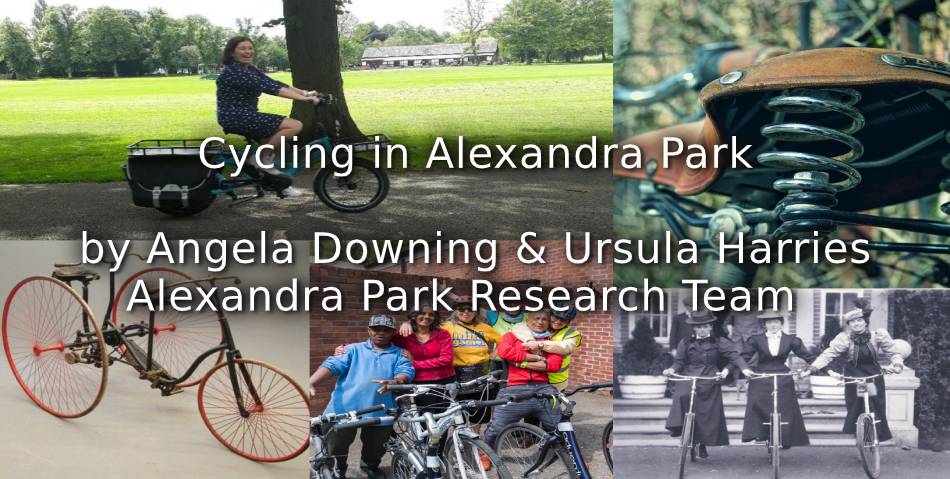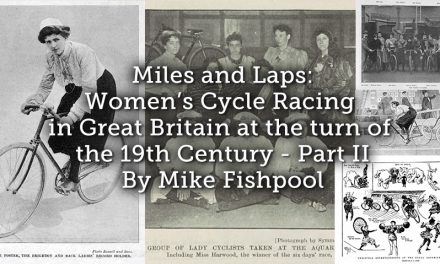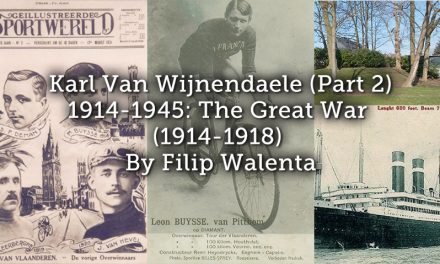Today, bicycles are much in evidence in Alexandra Park and the transpennine cycle route goes through it. Children enjoy the many paths to try out their cycling skills and it is a good form of exercise for everyone.

Mum and son cycling through the park
Photo credit – Karl Brockbank
Reproduced by kind permission of Friends of Alexandra Park Manchester’s Amateur Photographic Competition 2019
Though cycling became very popular in the closing decades of the 19th Century, it was not allowed in Alexandra Park. The first mention of cycling in the park is in reference to this ‘ongoing ban on bicycles’ which was reported in the Manchester Courier and Lancashire General Advertiser in a letter dated 7 June 1876.
The letter is from ‘Bicyclist’ who complained about being ‘roughly ordered’ out of Alexandra Park by an attendant who wanted ‘them to remove the bicycles’. The Bicyclist also wrote that the attendant had said he had been told to ‘turn all velocipedes out of the Park, whether on the carriage drive or not.’ He continued by saying that ‘there was nothing on the bye-laws on the park gates but were told by someone ‘evidently in authority’ at the Lodge that while no bye-law, there was a standing order and he would have them forcibly ejected’. The writer wanted to know ‘why bicycles cannot use the fine gravel paths when carriages, perambulators and other vehicles can and whether this threat was legal’.
The situation changed in 1882. This report is from the Bicycle Union- Manchester Local Centre.
This was the first meeting of the local group with Mr. Chapman being the honorary secretary and was held Monday evening. Membership of the local centre grew to over 160 members after the Whalley Range Bicycle Club joined the Manchester Local Centre. Mr. Chapman put forward a motion to request a petition which will ask for Bicycles to be allowed into the Alexandra Park between 6am and 9am. He suggests there will be some disagreement, but it is a modest proposal. Motion carried. It was also agreed that copies of this report of the Local Centre will be sent to the Athletic News, Bicycle News and the Cyclist.
The park committee granted permission but only before 8am and only during the summer opening.
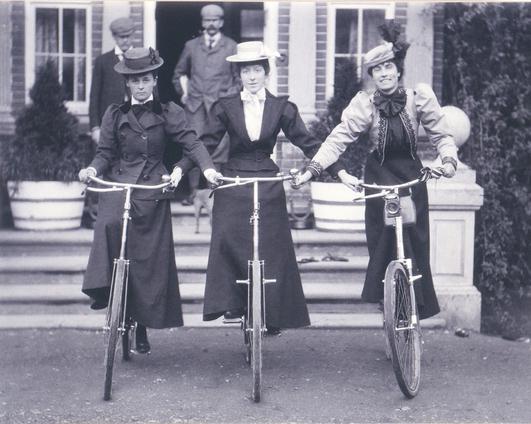
Women setting off for a cycle ride 1898
A report in the athletic union of 26 April 1882 of the Meeting of Manchester and District Local Centre reports that the park subcommittee has agreed to a request to hold a Bicycle Meet in Alexandra Park, 24 June 1882. Mr. Oxley had become the chair of the organizing secretary.
The Manchester and District Bicycle Union planned the first bicycle meet in great detail and invited other groups to join them. The ride was to include many circuits of the park before leaving for a ride to the city centre which would end with a ‘big dinner’ in a restaurant under the exchange.
A report to the Manchester Courier and Lancashire General Advertiser noted that the Bicycle Meet attracted 17 clubs and included clubs from Liverpool. There were 270 bicyclists and 33 tricyclists making a total of 303 machines. The Procession started from Alexandra Road Gate, round the large lawn, past the Bowling Green and out the Chorlton entrance along Clarendon road and back in the main entrance, this circuit was repeated and until finally the procession would leave from the Chorlton entrance across Alexandra Road, along Yarbrough Road, Chorlton Road, Stretford Road, Oxford Street and onto the Exchange.
Athletic News report on the cycle meet. A full report outlining the meet, the poor weather in the morning giving way to beautiful in time for the event; the attendance of Mayor and Aldermen. ‘Looking at the beautiful surroundings led one to believe that a more charming sport could not have been selected for the gathering…’ Further noting that the spectators were vast in numbers but well behaved and outlined the procession and participants.
After the event, Mr. Chapman, who replaced Mr Oxley as the organizing secretary, noted that tricyclists can go about at any time during the day (in Alexandra Park), while as a cyclist he could not – reiterated the petition (allow more cycling). Speeches afterwards see the Mayor praised and say he knows the value of cycling for the youth. Also, a suggestion that bicycles may well be allowed in the park at some point, followed by other toasts and general praise of the meet.
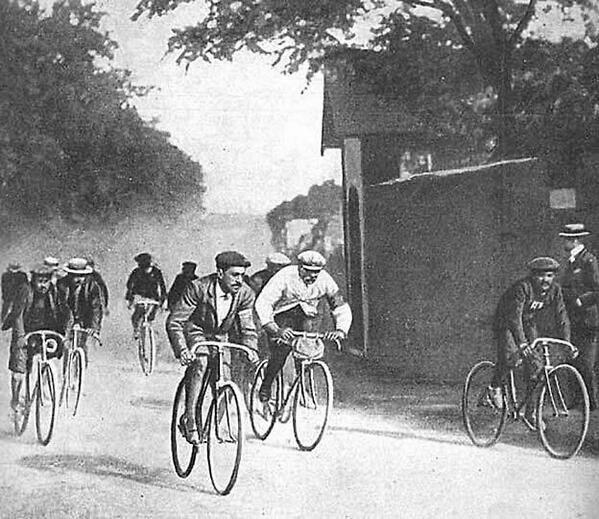
A cycle race
A report in the Athletic News notes the good work of the Local Centre, although suggested that the park is perhaps a bit small for such a gathering. It suggests that there were 10,000 spectators in and around the park, with a few spills owing to slippery pavements, however, different numbers counted at the meet made the total 314.
The Bicycle Meet was such a great success that the following year the committee gave permission for a further rally, but limited cyclists to two circuits of the park.
In Manchester Evening News on 5 May 1883 there was an ‘Anticipatory’ report on the cycle meet in Alexandra Park. The Mayor hoped to be there, as do other officials. 31 clubs were signed up, including those from Leeds, Liverpool, Huddersfield, Leamington. The report notes that the people last year were the largest number of people at one time in the park, indicating the interest in the sport. They also note that now 3-wheelers are allowed into the park, there will be an increase in tricycles and no doubt a great number from the ‘fair sex’. There was also an expectation that the US Consul will be at the dinner.
The event was reported in full in the Manchester Guardian on 4 June 1883. The article noted the huge number of spectators in the park ( possibly 10,000) and counted 293 cyclists attached to clubs, 220 unattached and 65 tricyclics, all of whom ‘saluted his worship the Mayor, by raising a hand to their caps’ as they cycled past the mayor.
The machines were there piled in pairs, and the owners stood ready to mount at sound of bugle and join the procession … All being ready the order was given to unpile, whereupon the bicyclists opened out, leaving room for two machines to pass down the ranks. The Young Men’s Christian Association Bicycle Club mustered well, in a serviceable uniform of grey, followed by the strongest club on the ground, the North Manchester…
The machines ridden were of every conceivable make, some of them being of a very elaborate and costly description. The riders were not exclusively of the male sex, and in one or two cases of a double tricycle a lady and a gentleman rode together. One gentleman had in front of him a little child, who seemed thoroughly to enjoy the situation, and at the back of another tricycle a seat was fixed, on which also sat a child.
However, the following year the Bicycle Meet moved elsewhere as it was decided that Alexandra Park was too small for such a large gathering. Bicycles remain forbidden but not tricycles.
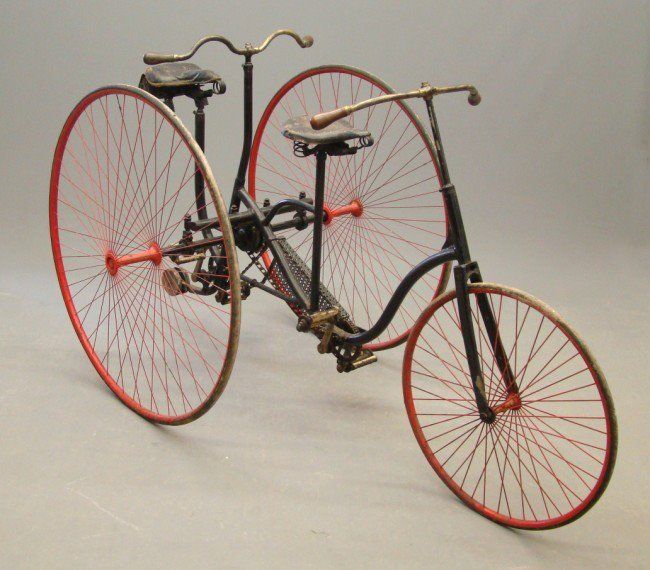
Typical tricycle of the day
In the Manchester Guardian on 25 September 1884 there is a letter from Edward Sutton about tricycles in parks.
As a frequent user of Alexandra Park, he notes that he frequently expects to hear of an accident as there are many young children not under control and the tricycles travel too fast. …the park is for children and those requiring fresh air and that tricycles are as much out of place as the forbidden bicycle and more dangerous than vehicles
The issue of cycling in the park continued and on 26 March 1896 in a letter to The Manchester Guardian,
AW suggests that on non-holiday days, there are very few (often less than 20) people in the park with the exception of the children in playgrounds, so it would be a good idea to allow cycling. It is 60 acres and could have a cycling track, fives court and running track. He wants a move from the ‘trim garden’ view of parks to one in which they are spaces of recreation.
In the Manchester Evening News on 7 April 1897 the Parks committee discusses allowing ‘lady cyclists’ to cycle on the Alexandra Park carriage until noon each day. Others suggest that if a gentleman can drive a cab through, then why can’t a working man cycle through? The suggestion is rejected.
Another letter to The Manchester Guardian on 31 August 1897 hints at problems with cycling in the park. The letter says that
It would be a shame if cycling in the parks was withdrawn because of a few young fellows using Alexandra Park ‘as a training ground.’ Such ‘scorching’ has no place in a public park and led to the letter-writer abandoning cycling in parks last summer.
The writer had also heard of ‘many ladies complaining of the danger to which they are exposed’.
However on the 18 March 1880 the park committee announced that
In the view of the committee it is ‘entirely inexpedient to allow bicycles within the park
The right to cycle in the park had been finalised.

Blossom Girls
Photo credit – Haidy Mayouf
Reproduced by kind permission of Friends of Alexandra Park Manchester’s Amateur Photographic Competition 2019
Cycling Today – The Bike Hive
A cycling project was set up in Alexendra Park in 2015 when a group of women from a local primary school decided they’d like to ride bikes with their children. Some could already ride though were out of practice, others had never ridden. So ‘Whalley Range on Wheels’ was born. Some bikes were provided by donations, including from a partner project in neighbouring Platt Fields Park. Support was also provided by a Manchester-based cycle training organisation, BikeRight, in the form of experienced cycling instructors to help the women get going.
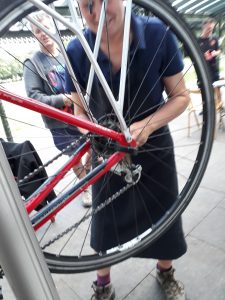
Maintenance
Photo credit – Ursula Harries, The Bike Hive
The project grew from these beginnings and in 2017 was renamed the Bike Hive. It continues to receive invaluable support from the City Council (use of storage facilities and a ‘brew room’), from Transport for Greater Manchester (who provide instructors for open cycling sessions) and from Cycling UK. The project has also had generous donations of bikes and equipment from local people.
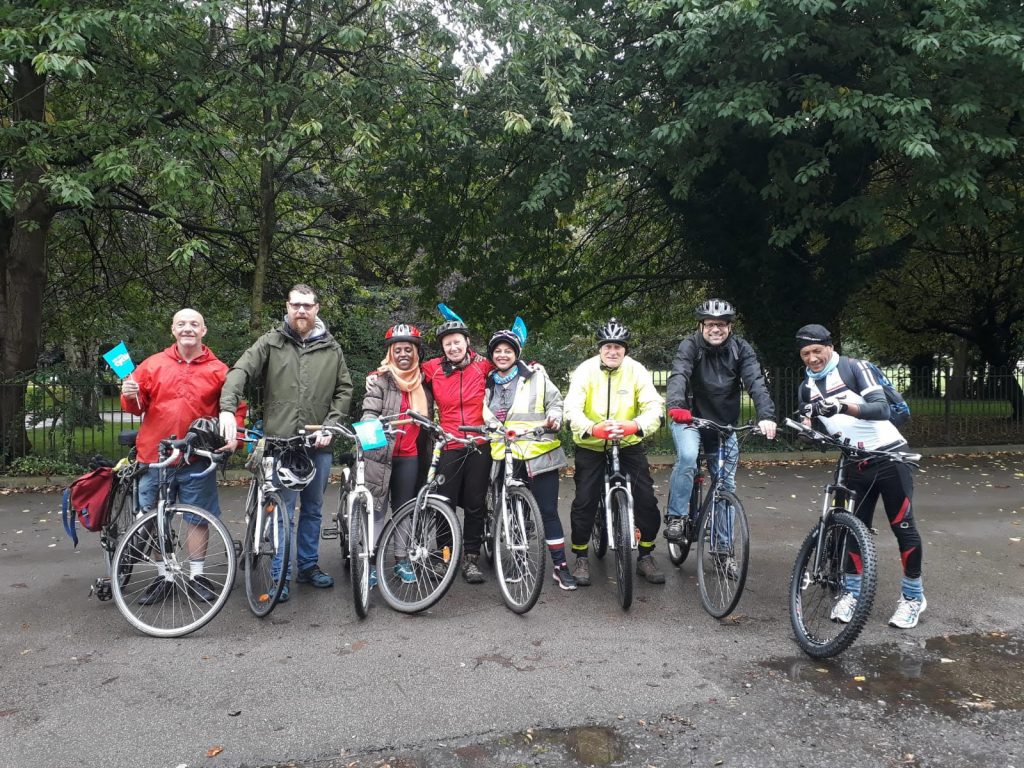
Ready to go, all friends together
We open our doors once a week for cycling lessons and a social ride. The project has worked closely with Refugee Action and City of Sanctuary, so a lot of cyclists come from these organisations. On a busy day there could be around 30 or so people using one of our bikes to enjoy the park. In the late 1800’s and early 1900’s some parks had ‘riding schools’ where adults could learn cycling skills – perhaps the Bike Hive provides the modern equivalent of this?
Why not pop along and read 3 stories from Bike Hive members. who talk about their experiences as cyclists and members of the group – click HERE
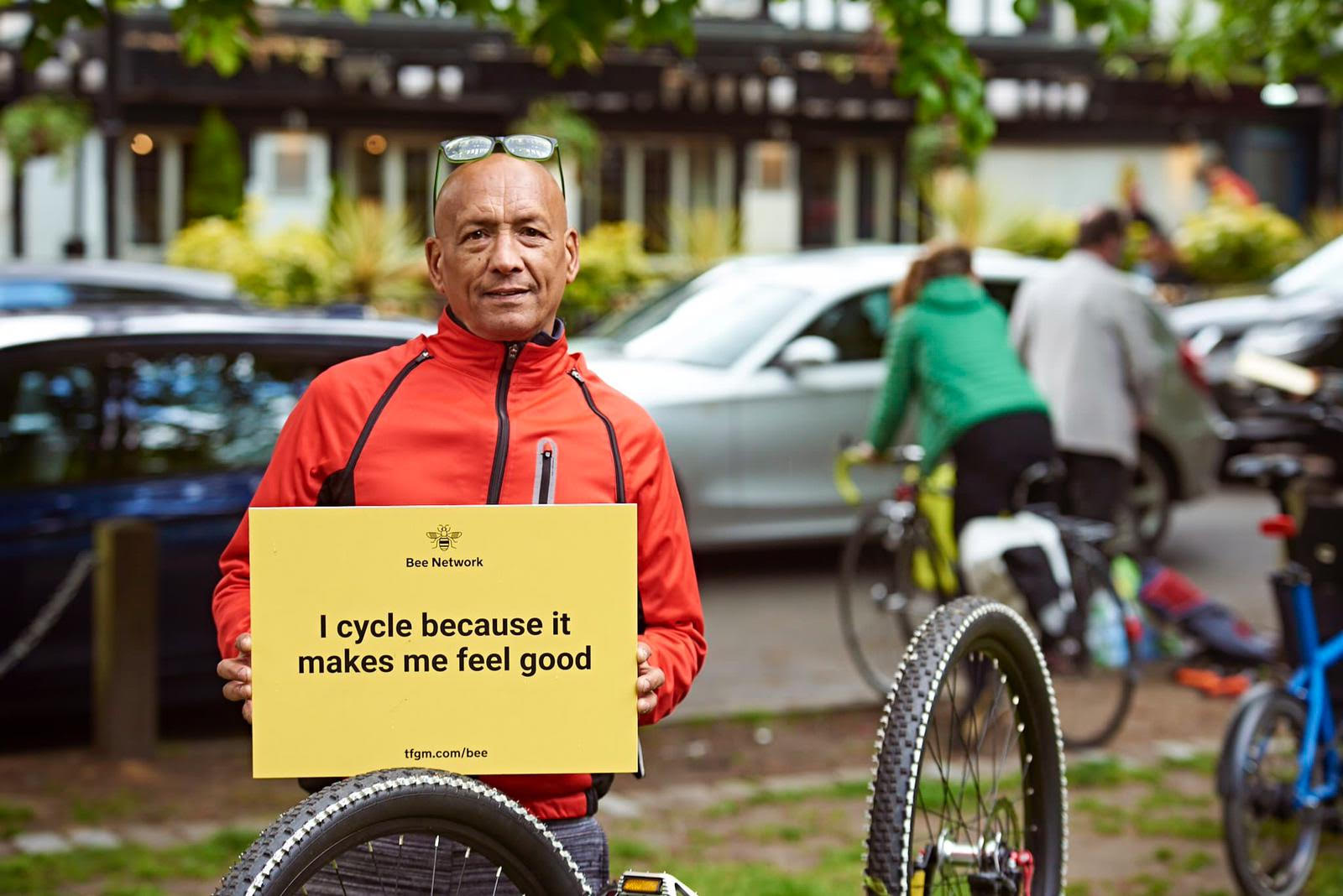
Why I cycle
Photo credit – Ursula Harries, The Bike Hive

